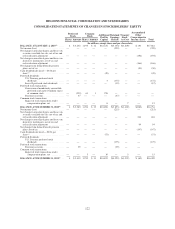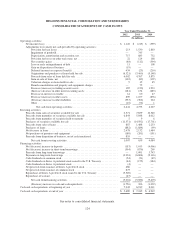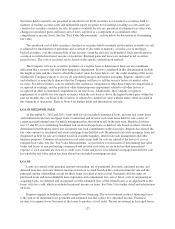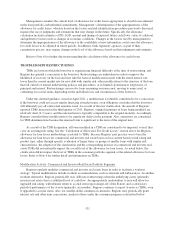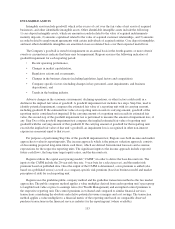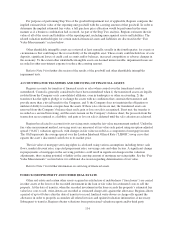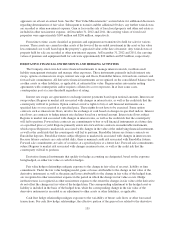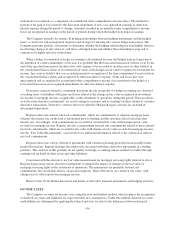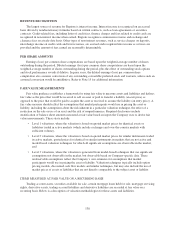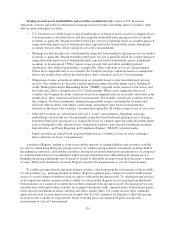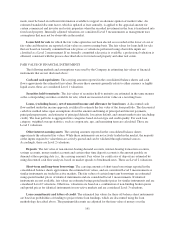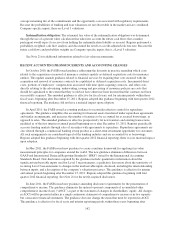Regions Bank 2012 Annual Report Download - page 148
Download and view the complete annual report
Please find page 148 of the 2012 Regions Bank annual report below. You can navigate through the pages in the report by either clicking on the pages listed below, or by using the keyword search tool below to find specific information within the annual report.
Modification Activity: Consumer Portfolio Segment
Regions works to meet the individual needs of consumer borrowers to stem foreclosure through the
Customer Assistance Program (“CAP”). Regions designed the program to allow for customer-tailored
modifications with the goal of keeping customers in their homes and avoiding foreclosure where possible.
Modification may be offered to any borrower experiencing financial hardship—regardless of the borrower’s
payment status. Under the CAP, Regions may offer a short-term deferral, a term extension, an interest rate
reduction, a new loan product, or a combination of these options. For loans restructured under the CAP, Regions
expects to collect the original contractually due principal. The gross original contractual interest may be
collectible, depending on the terms modified. The length of the CAP modifications ranges from temporary
payment deferrals of three months to term extensions for the life of the loan. All such modifications are
considered TDRs regardless of the term because they are concessionary in nature and because the customer
documents a hardship in order to participate.
Modified loans are subject to policies governing accrual/non-accrual evaluation consistent with all other
loans of the same product type. Consumer loans are subject to objective accrual/non-accrual decisions. Under
these policies, loans subject to the CAP are charged down to estimated value on or before the month in which the
loan becomes 180 days past due. Beginning in the third quarter of 2011, home equity second liens are charged
down to estimated value by the end of the month in which the loan becomes 120 days past due. If a partial
charge-off is necessary as a result of this evaluation, the loan is placed on non-accrual at that time. Because the
program was designed to evaluate potential CAP participants as early as possible in the life cycle of the troubled
loan, many of the modifications are finalized without the borrower ever reaching the applicable number of days
past due, and with the loans having never been placed on non-accrual. Accordingly, given the positive impact of
the restructuring on the likelihood of recovery of cash flows due under the modified terms, accrual status
continues to be appropriate for these loans.
If loans characterized as TDRs perform according to the restructured terms for a satisfactory period of time,
the TDR designation may be removed in a new calendar year if the loan yields a market rate. A minimum of six
months’ consecutive payments is required in order to demonstrate a performance history sufficient to remove the
TDR designation. The market rate assessment must be made at the date of the modification considering the terms
that would be offered to a new borrower with a similar credit profile. Given the types of concessions currently
being granted under the CAP as described above, Regions does not expect that the market rate condition will be
widely achieved; accordingly, Regions expects loans modified through the CAP to remain identified as TDRs for
the remaining term of the loan.
PREMISES AND EQUIPMENT
Premises and equipment are stated at cost, less accumulated depreciation and amortization, as applicable.
Land is carried at cost. Depreciation expense is computed using the straight-line method over the estimated
useful lives of the assets. Leasehold improvements are amortized using the straight-line method over the
estimated useful lives of the improvements (or the terms of the leases, if shorter). Generally, premises and
leasehold improvements are depreciated or amortized over 7-40 years. Furniture and equipment are generally
depreciated or amortized over 3-10 years. Premises and equipment are evaluated for impairment whenever events
or circumstances indicate that the carrying value of the asset may not be recoverable. Maintenance and repairs
are charged to non-interest expense in the consolidated statements of operations. Improvements that extend the
useful life of the asset are capitalized to the carrying value and depreciated. See Note 8 for detail of premises and
equipment.
Regions enters into lease transactions for the right to use assets. These leases vary in term and, from time to
time, include incentives and/or rent escalations. Examples of incentives include periods of “free” rent and
leasehold improvement incentives. Regions recognizes incentives and escalations on a straight-line basis over the
lease term as a reduction of or increase to rent expense, as applicable, in net occupancy expense in the
consolidated statements of operations.
132


